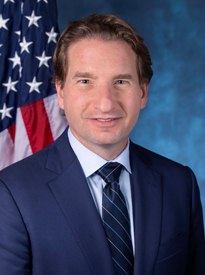Dean Phillips and a Review of Minnesota US Reps Running for President
Only one sitting U.S. Representative has run for the nation’s highest office in Minnesota history

While no doubt many Democratic voters and office holders agree with Phillips’ message, it is perhaps a bit surprising for some to learn this three-term congressman is flirting with a bid.
Rep. Phillips is not particularly well-known outside of Minnesota and the track record of presidential candidacies by sitting U.S. Representatives outside of the election of James Garfield in 1880 is poor. Dozens have tried and none have succeeded.
In Minnesota, only one sitting U.S. Representative has ever run for president.
In 2012, three-term 6th CD Republican Michele Bachmann (CD 06, 2007-2015) entered the race in late June 2011, but ended her bid after the Iowa Caucuses in early January 2012 after a disappointing sixth place finish.
She received one vote at the nominating convention that August.
A few ex-U.S. Representatives from the Gopher State have left slight footprints in the history of presidential electoral politics.
Duluth attorney and state judge advocate general Charles Towne flipped the state’s 6th CD seat in 1894 – knocking Democratic freshman Melvin Baldwin out of office.
In July 1896, however, Towne left the GOP and was the nominee of both the Democratic and People’s Party that November. Towne lost to Republican 11th Judicial District Court Judge R. Page Norris by less than 1,000 votes and then by less than 500 votes in the 1898 rematch.
Towne won 42 votes for the Democrats in the 1899 U.S. Senate election and a few years later left the state to practice law in New York.
In July 1904, Towne received two votes for president from Minnesota delegates at the Democratic National Convention. [That fall, Towne was elected to the U.S. House as a Democrat to New York’s 14th CD].
Over a half-century later, another ex-U.S. Representative from Minnesota received notice at the Republican National Convention – former 10-term congressman and Minneapolis physician Walter Judd.
Judd represented Hennepin County in the 5th CD from 1943 until losing a bid for his 11th term in 1962 by 3.6 points to State Senator Don Fraser.
At the 1964 RNC, however, Judd was a ‘favorite son’ candidate for president with state GOP Chair Robert Forsythe nominating him at the San Francisco convention that July.
Judd received 18 votes on the first ballot from the Minnesota delegation (with eight still going to nominee Barry Goldwater) plus three delegates from North Dakota and one from Alaska for 22 in total.
Two other former Minnesota U.S. Representatives also received votes at presidential conventions, although they were sitting U.S. Senators at the time.
Republican Winona attorney William Windom served in the U.S. House for five terms – two as an at-large U.S. Representative (1859-1863) and three from the 1st CD (1863-1869).
In 1880, Windom was near the end of his first of two stints in the U.S. Senate (1871-1881, 1881-1883) when his name was placed into nomination by former Minnesota State Senator and railroad president Elias F. Drake.
Windom received all 10 votes from the Minnesota delegation on the first ballot. [Windom’s support did not begin to peel off until the 29th round of balloting].
Lastly and most famously, St. Paul’s Eugene McCarthy made several presidential runs, most notably in 1968 challenging Vice President and fellow Minnesotan Hubert Humphrey.
McCarthy represented the 4th CD from 1949 to 1959 and was a sitting DFL U.S. Senator (1959-1971) during his first presidential bid.
McCarthy won a half-dozen primaries and 601 delegates at the DNC in Chicago.
It should be noted that sitting U.S. Representatives Bob Bergland (CD 07, 1971-1977) and Rick Nolan (CD 06, 1975-1981; CD 08, 2013-2019) each received convention votes for vice president at the 1972 and 1980 Democratic National Conventions respectively.
Bergland received five votes and Nolan won four.
Follow Smart Politics on Twitter.

{Unrelated to article}
In the Buckeye State, “Issue 1” – the 2023 version – lost, and by an unexpectedly lopsided margin (about 43%/Y to 57%/N; results unofficial).
* I am not aware of any state Democrat (at least of statewide prominence) who advocated for this attempt at amending the state constitution – whereas quite a few Republicans opposed it;
* The measure not only fared poorly among non-election day voters and residents of metropolitan counties, but underperformed among ‘day voters’ (i.e. even narrowly losing among those voting on election day, per the Associated Press) and in rural venues (e.g. it failed in Clark County by a single vote, 16015 to 16014, and passed by only 50.3% to 49.7% in Butler County; both places voted strongly Republican in recent elections at all levels);
* Ironically, a proposal that sought to raise the threshold for future amendments to the state constitution – to 60%! – itself required only a 50%+1 threshold to become effective. Alas…
Interesting story about OR. They have a history of secretaries of state leaving office early. Norma Paulus who was there from 1977-1985 is the last who did not leave early or get appointed at the start.
Barbrara Roberts resigned in 1991 to be governor. Phil Keisling was then appointed, he resigned in 1999.
Bill Bradbury was then appointed and he finished 2 full terms in 2009. Kate Brown was elected in 2008 and reelected in 2012 but ascended to the governorship in 2015. Jeanne Atkins was then appointed but didn’t seek the full term. Dennis Richardson was then elected in 2016 but passed away in 2019. Bev Clarno was then appointed but seek the full term. Shemia Fagan was elected in 2020 but resigned in 2023. LaVoone Griffin-Valade was the appointed but has said that she won’t run in 2024.